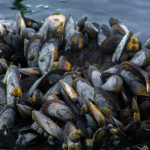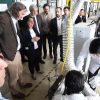Human fecal contamination in aquatic ecosystems, whether fresh or saltwater, is a global concern, as specific human pathogens, that can return through sea-based leisure activities or foodstuffs, are found in it. To resolve this, tracing their origin is key.
By Constanza Ruiz / construiz@udec.cl / Photographs: Oceanografía UdeC
The relationship between human health and the ocean is undeniable. Seafood has been key in the evolution of our species, and for aquatic ecosystems in general. The ocean is used for transport, production, recreation, conservation, and ultimately, it is also considered a reservoir
of bioactive substances. However, for millennia, we have also used the ocean to discard waste from anthropogenic activities, in part based on the misconception that oceans can absorb and recycle all kinds of contaminants.
However, the hepatitis A virus, norovirus, coxsackievirus, and ultimately SARS CoV-2, among others, along with antibiotic-resistant bacteria, persist, and are spread through water, being able to return to humans through seafood, leisure activities in direct contact with contaminated water or sand. These, among other ways, alongside the effects of climate change in coastal areas,
increase the risk of thalassogenic diseases caused by the ocean.
On the Chilean coast, contamination with human feces is widespread. According to the Superintendence of Sanitary Services (SISS, in Spanish), there are 33 outfalls in operation, with over 50% of them located between the Valparaíso (9) and Biobio (8) regions, along with storm drains and different sources that discharge fecal matter into the coastal area and freshwater bodies, including wetlands. For example, in the Bay of Concepción, two outfalls serve approximately 110,000 inhabitants, which can discharge 200g of fecal matter per person daily, with a total of 22 tons of human fecal matter a day.
The presence of fecal contamination in water is always negative, but when it comes from human beings, the health risk is much higher. On measuring fecal bacteria in the water to determine
contamination, it is not possible to identify what organism it has come from. Determining total and fecal coliforms is a laborious technique that is over 100 years old. It determines the probability of the presence of fecal bacteria in 100ml of water, the equivalent of a cup of tea. The
Chilean Standard 1333 (NCh 1333), which lays out the criterion for water quality for watering and leisure, establishes that fecal coliforms for these uses must be equal to or less than 1000 NPM per 100 ml. To eradicate fecal contamination, it is necessary to evaluate this risk and trace its origin, something that is not possible through classic colimetry.
The experience of Tortel and Biobío
Tortel Cove, which has suffered substantial contamination from human feces caused by the wastewater being directly discharged into it, was the starting point for the research made by
Rodrigo González Ph.D., Professor of the Oceanographic Department of the Universidad de Concepción’s Faculty of Oceanography and Natural Sciences. In the 2021 version of the Impact Science awards, organized by the University’s Transfer and Licensing Office, he was recognized in the “Invention Protection” category, for having created a method that allows tracing contamination with human feces in aquatic systems, an invention that last year was presented for
a patent application before the National Industrial Property Institute (INAPI, in Spanish).
Human mitochondrial DNA (mDNA), present in the epithelial cells which break off the intestine in each evacuation, has been used to trace human fecal contamination, especially in freshwater
systems where mDNA concentration is high enough to be detected. “Traceability of fecal pollution and thalassogenic diseases: the spatial and time match between the maximum concentration of human mDNA in seawater and the outbreak of hepatitis A in the coastal population”, made by Dr.
González, was published in the Science of the Total Environment Journal, and is the first piece of work that shows that, in a marine ecosystem, there is a time-space match between human fecal
contamination and Hepatitis outbreaks in the Biobio Region.
This type of methodology is not just useful in large scale environmental studies, but it can also be an effective tool to monitor microbiological quality and the possible risks for human health; for
example, to evaluate the sources of rural drinking water supply, aquaculture production areas, leisure and tourism areas, considering a climate change scenario (drought) like the one our country is facing today.
For more information: rogonzal@udec.cl
Last modified: 2 de junio de 2023






